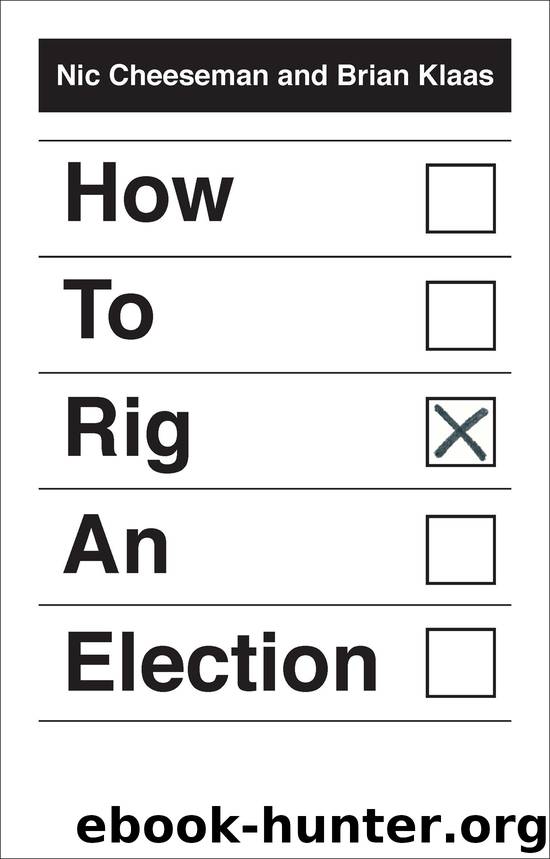How to Rig an Election by Nic Cheeseman

Author:Nic Cheeseman
Language: eng
Format: epub
ISBN: 9780300204438
Publisher: Yale University Press
Selecting a strategy
Although often used together, it is important to distinguish between ballot-box stuffing and fraudulent counting, because they have different strengths and weaknesses. Fudging the numbers during counting is usually easier. Instead of mobilizing underage voters or filling out thousands of ballots, it simply requires a small number of people to be willing to change the numbers at a given stage in the process. As a former election observer told us, ‘You just have to take out your pen and add a zero to the total, or change a one to a nine. It is as simple as that.’44 This saves the need for developing and paying for a large, complex, organized operation. Fudging the numbers is perhaps the most efficient of all forms of election rigging.
However, this pro comes with a con: fixing the poll by inaccurately adding up the tallies from different polling stations is vulnerable to detection. Opposition candidates might notice large discrepancies between the tallies, especially if they are able to mobilize party agents to record polling station results and then generate an alternative count. Similarly, international observers and academics have developed new techniques to detect whether a set of results has been manipulated. One of these relies on the fact that while the final digits of a set of figures that come about by chance are likely to be equally distributed, the human brain tends to opt for some numbers more than others, resulting in a distinctive pattern.45 As a result, by entering a full set of results into a computer program, analysts can determine whether or not they are likely to have been manipulated. These forms of detection are particularly problematic where tallying fraud is concerned, because if the election is sufficiently dubious to inspire a re-count, there will not be sufficient votes in the actual ballot boxes for the ruling party to substantiate the official result.
By contrast, stuffing the ballot box with fraudulent votes suffers from no such drawback, because it generates a paper trail that can subsequently be invoked as an example of electoral quality. Once a candidate’s total has been topped up by adding illegitimate votes, the process of counting and tallying can be allowed to take place transparently, with the candidate safe in the knowledge that the required votes have already been secured. This means that the rigging process is better insulated against a forensic audit of the result. For example, if there is a re-count, observers and monitors will find the ‘correct’ number of votes in each ballot box. Everything will therefore appear to be above board, so long as the total number of votes in a precinct does not exceed the number of voters registered in that area.
However, while ballot-box stuffing is less vulnerable to exposure after the fact, it suffers from other drawbacks. Most obviously, it requires considerable effort and planning. For example, if underage party supporters are to be used they need to be identified and mobilized in the same way as any other voter, and this comes at a cost.
Download
This site does not store any files on its server. We only index and link to content provided by other sites. Please contact the content providers to delete copyright contents if any and email us, we'll remove relevant links or contents immediately.
The Secret History by Donna Tartt(16723)
The Social Justice Warrior Handbook by Lisa De Pasquale(11506)
Thirteen Reasons Why by Jay Asher(7833)
This Is How You Lose Her by Junot Diaz(5829)
Weapons of Math Destruction by Cathy O'Neil(5080)
Zero to One by Peter Thiel(4867)
The Myth of the Strong Leader by Archie Brown(4809)
Promise Me, Dad by Joe Biden(4478)
Beartown by Fredrik Backman(4465)
How Democracies Die by Steven Levitsky & Daniel Ziblatt(4448)
Stone's Rules by Roger Stone(4438)
The Fire Next Time by James Baldwin(4373)
100 Deadly Skills by Clint Emerson(4108)
A Higher Loyalty: Truth, Lies, and Leadership by James Comey(4059)
Rise and Kill First by Ronen Bergman(4045)
The David Icke Guide to the Global Conspiracy (and how to end it) by David Icke(3913)
The Farm by Tom Rob Smith(3895)
Secrecy World by Jake Bernstein(3808)
The Doomsday Machine by Daniel Ellsberg(3758)
